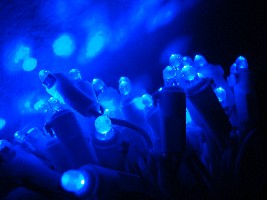Materials scientists at University of Florida in Gainesville have developed a new manufacturing process for light-emitting diodes, or LEDs, used in flat-panel displays and solid-state lighting. The process is described in an article now appearing in the journal Nature Photonics (paid subscription required), and has been licensed to a company for commercialization.
Two research teams at Florida took different paths in addressing improvements in LEDs. One team started with current organic LEDs used in flat-panel displays and lighting. These semiconductors are multilayered structures made up of thin organic materials, such as polymer plastics.
Another team started with quantum dots, which are crystals measuring a few nanometers (billionths of a meter) wide, made of sulfur, zinc, selenium and cadmium atoms. When excited by electricity, quantum dots emit an array of colored light, where the colors can be varied by adjusting the size of the dots.
The two teams merged their efforts to come up with a hybrid form of LED that combines both organic and quantum-dot layers. This achievement is important in LEDs, because each method had radically different manufacturing processes: vacuum deposition for organic LEDs and spin-coating for quantum dots. The Florida researchers leapfrogged this problem by creating a single process for manufacturing LEDs with both organic and quantum-dot components.
That process described in the research article — for which a patent has been granted — involves depositing all particles and molecules needed for the LED entirely with spin-coating. This structure, according to the authors, offers improved device efficiency and longer lifetimes compared to earlier LED devices based on quantum dots.
“Manufacturing costs will be significantly reduced for these solution-processed devices, compared to the conventional way of making semiconductor LED devices,” says Jiangeng Xue, professor of materials science and engineering, and research leader.
The university has licensed the LED process to a start-up company NanoPhotonica in Orlando, Florida. The company plans to enhance the technology further to take advantage of high-output roll-to-roll manufacturing processes used today in most printing and coating industries.
Read more: Researchers Improve Efficiency of LED Lighting
* * *


 RSS - Posts
RSS - Posts
[…] Manufacturing Process Devised for More Economical LEDs […]